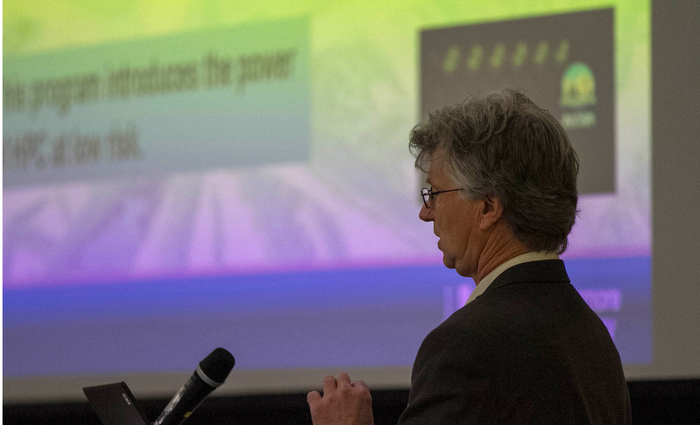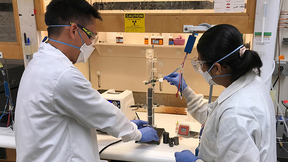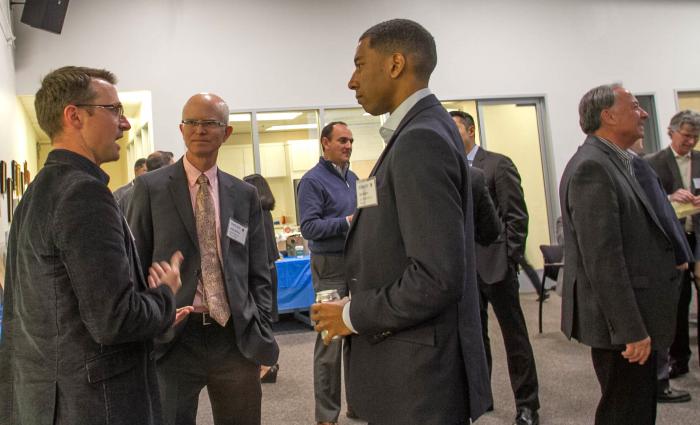Lab and DOE representatives meet with industry, academia to discuss investing in clean energy
 (Download Image)
Jeff Roberts, Lawrence Livermore's deputy director for Energy and Climate Security, discussed the High Performance Computing for Manufacturing program, in which commercial partners are assigned an expert to evaluate if their businesses could benefit from the Lab’s supercomputers. Photos by Julie Russell/LLNL
(Download Image)
Jeff Roberts, Lawrence Livermore's deputy director for Energy and Climate Security, discussed the High Performance Computing for Manufacturing program, in which commercial partners are assigned an expert to evaluate if their businesses could benefit from the Lab’s supercomputers. Photos by Julie Russell/LLNL
Representatives from Lawrence Livermore and 10 other national laboratories met last Thursday with Department of Energy officials, investors and academic institutions for the inaugural Laboratory-Investor Knowledge Seminar (LINKS) to discuss strategies to better transfer clean energy technologies from the labs to the private sector.
The event, held at Innovate Pleasanton and hosted by the Department of Energy’s Clean Energy Investment Center and LLNL’s Industrial Partnerships Office, highlighted success stories of lab partnerships and spinout companies formed from technology originating at the national laboratories, especially in areas such as high performance computing, energy storage and lightweight materials.
"Connecting with industry is essential," said Industrial Partnerships Office Director Rich Rankin. "It’s important to get investors involved to find faster and innovative ways to get laboratory technology into the marketplace. We want to create better awareness of the laboratories’ offerings in the energy space, make connections into the Clean Energy Investment Fund and demonstrate that the labs can and will collaborate to solve energy challenges."
In welcoming attendees, the Lab’s Deputy Director for Science and Technology Pat Falcone noted the role of the Lab in the Bay Area’s innovation ecosystem, adding the competitive spirit of the national labs could work to private industry’s advantage.
"There’s a real urgency in how we get to those benefits more quickly, that’s the motivation behind this incredible effort," Falcone said. "We hope we can get some good value for the taxpayer and for clean energy technology."
Among the presentations, LLNL Deputy Director for Energy and Climate Security Jeff Roberts gave attendees an overview of the High Performance Computing for Manufacturing (HPC4Mfg) program, in which commercial partners are assigned an expert to evaluate if their businesses could benefit from the Lab’s supercomputers. Examples of successful partnerships include efforts in steelworking and SORAA, a company specializing in LED lights.
Roberts said the program is a way for companies to save time and money by modeling instead of having to run expensive experiments. So far, Roberts said, HPC4Mfg is showing a strong impact and promise in clean technology.
"It’s important to communicate to industry what capabilities exist at the Lab that can help them and how to approach businesses to work with them effectively," Roberts said. "High performance computing is a low-risk way for industry to test out their ideas."
DOE currently has a $5.7 billion budget for clean energy research and development, according to Clean Energy Investment Center Director Sanjiv Malhotra, who described how the signing of the Paris agreement is impacting the national labs to move faster on clean energy.
"Paris marked a new era of bringing in investors who are starting to think about clean energy in a new way," Malhotra said. "We are a conduit for making these technologies move from the lab, where it is seen as discovery science, to the private sector. This event is hopefully the first of a series of events where we can bring these entities together and head toward more public-private partnerships."
Malhotra said there has been a steady decline in recent years of venture capital investment in clean technology, underscoring the need to better connect with investors to bring technology from the labs to the marketplace.
"These are investors who are very good at investing at various technologies, but in clean tech, there are layers to go through regarding risk and how much money we have to spend to get from early stage to market," Malhotra said. "Our focus is to do handholding of the investors. When it comes to energy technologies, we would like to provide a solid point of contact."
To help expand the commercial impact of DOE’s portfolio of R&D activities, the Office of Technology Transitions, which opened last February, is looking to increase private sector cooperation in high-impact areas such as power grid modernization, cybersecurity, energy storage and fuel-engine optimization.
The DOE’s Technology Commercialization Fund also gives out $20 million annually to mature promising energy technologies at the national labs.
Representatives from Brookhaven, Pacific Northwest, Lawrence Berkeley, Idaho, National Energy Technology Laboratory, Stanford Linear Accelerator, the National Renewable Energy Laboratory, Thomas Jefferson Lab, Sandia National Laboratories and Argonne National Laboratory attended the event.
Other successful private-public partnerships discussed during the panels included the joint LLNL/Sandia work on the Cummins Engine project, the first diesel engine designed entirely by a computer simulation, CalCharge for energy storage, the Lightweight Materials Consortium and the Joint Center for Energy Storage Research at Lawrence Berkeley Lab, which is developing a successor to the lithium-ion battery.
Contact
 Jeremy Thomas
Jeremy Thomas
[email protected]
(925) 422-5539
Related Links
U.S. Department of Energy's Clean Energy Investment CenterDO Office of Technology Transitions
High Performance Computing for Manufacturing
Tags
Economic ImpactIndustry Collaborations
Technology Transfer
Energy
Featured Articles








